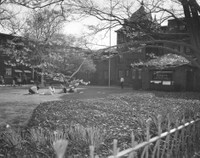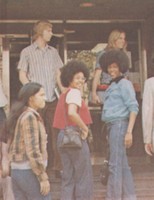
According to Abraham Abuchowski CCAS ’70 “We all try to accomplish great things, but it’s about how we carry ourselves, our personal integrity, that really makes us who we are. That’s how we all hope to be remembered.” Abuchowski, now a pharmaceutical pioneer who creates drugs to treat childhood diseases, spoke these words not at his own graduation, but to graduates of the Rutgers–Camden Class of 2009 when he served as commencement speaker. The importance of personal integrity, however, could be a lesson learned from the 1970s.
The college ended the turbulent sixties with a new name and a glimpse of the era of growth ahead. After several years of discussion, Rutgers College of South Jersey officially became Rutgers University, Camden College of Arts and Sciences when the Board of Governors approved the change on April 10, 1970. The campus had grown in resources and stature enough to make it possible for the nearly 250 members of the Class of 1970 to be the first to have commencement exercises on campus, instead of attending graduation in New Brunswick.
By the time that first on-campus ceremony took place, construction had begun on a new law school building, and thanks to the passage of a 1968 bond issue, two more major undergraduate/graduate buildings became feasible. Even the section of Penn Street, between Third and Fourth Streets had finally closed – a prelude to a campus that would look more like a beautifully landscaped park.

Dr. James E. Young, chair of the Department of Ceramic Engineering at the State University of New York, was named RUCCAS dean in July 1970. The campus continued to flourish and in the fall of 1970 enrollment increased to 1,787 undergraduates, a tripling of the student population from just a decade before. In May 1973, Young resigned and was replaced by Dr. Walter K. Gordon of the Rutgers–Camden English department, first as acting dean, then as dean in July 1974.
In the fall of 1973, the campus’ first gymnasium opened. The $3.1 million facility boasted a pool, basketball court, locker rooms, teaching spaces and offices within 55,280 square-feet of space. This was a far cry from the years of gym classes at the Camden YMCA. During this time, the college also secured the Delaware River Port Authority’s former maintenance building for development into a University Police/physical plant center.
Rutgers–Camden athletics (nicknamed “The Pioneers”) began to make its mark. In 1977, Ray Pace became the first Rutgers–Camden basketball player to be selected in the NBA draft (sixth round by the Boston Celtics). In 1979, the golf team won the NAIA District 19 golf championship; the same honor is earned again in 1980
Additional facilities continued to be unveiled on campus. In September 1974, the $4.7 million Fine Arts Building opened its classroom and office wing. The facility that now houses the Gordon Theater and Stedman Gallery opened in January 1975. The impressive 65,000 square-foot structure made it possible at last for Rutgers–Camden to sponsor major public events in an attractive modern setting.

The first phase of a major landscaping effort began in 1975, when a parking lot at Fourth and Penn Streets was transformed into an attractive central mall with brick walkways, trees, shrubbery, and grassy knolls. Traffic ceased to rumble through campus in the summer of 1980 when Fourth Street was finally closed between Lawrence Street and the Benjamin Franklin Bridge. By the close of the seventies, the “sidewalk campus” of the previous decade had been transformed into a flourishing campus with tree-lined walkways and open lawns.
The new decade brought a change from the student activism of the last decade. The student of the seventies was more interested in practical career-oriented education and by the fall of 1973, 20% of the entire student population had declared a major in business or economics, a 42% increase over the number of students selecting that field just two years earlier. A nursing program, established in 1973, enrolled 52 students in its first year and grew to 172 students the next.
Rutgers–Camden also began attracting non-traditional students: older men and women attending college on the G.I. Bill or years after graduation from high school. These older students brought “adult” concerns with them, such as a need for job counseling or daycare. New women’s organizations including “Antigone” and “The Women’s Coalition” reflected the growing feminist movement and promoted programs, like a regional conference on rape.
Toward the end of the 1970s, campus life would change dramatically with the construction of student housing. In 1977, a
survey was made of all those admitted to Rutgers–Camden that fall, but who chose not to attend. Forty percent of those who responded said they went elsewhere because the campus did not having housing facilities. Another study that year identified a strong interest in on-campus residence among already enrolled students. By 1978, Rutgers was seriously considering the addition of student housing at both the Camden and Newark campuses.While the physical campus was changing greatly, what students recall of Rutgers–Camden during these years is the people. A passage from the 1971 student yearbook offers this observation: “What is Rutgers? It is many things. It is lively classrooms; it is battered textbooks; it is crowded lunchrooms; it is busy offices; but most of all, it is memorable people. There are friendly people, happy people, busy people, and fascinating people…The people who come every day bringing some small part of their lives to us, and leave taking some small part of us with them. These may be the very people who mold our character into what it will be tomorrow.”
Media Contact: Cathy K. Donovan
(856) 225-6627
E-mail: catkarm@camden.rutgers.edu